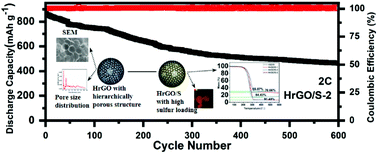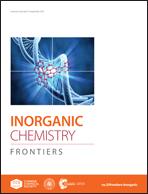Three-dimensional hollow reduced graphene oxide spheres with a hierarchically porous structure for high-performance lithium–sulfur batteries†
Abstract
Herein, a three-dimensional hollow reduced graphene oxide (HrGO) with a hierarchically porous structure was successfully synthesized to load sulfur, where the sulfur loading could reach as high as 91.4 wt%. This stable structure was obtained by the chemical-assisted reduction of oxygen-containing groups and polyvinyl pyrrolidone, removal of silica templates, and freeze drying. Owing to the hierarchical pores and doped nitrogen in HrGO, the HrGO-supported sulfur (HrGO/S) cathode exhibited superior electrochemical performance with high rate capacity and long cycling life. HrGO/S with the sulfur content of 84.43 wt% delivered the high specific capacity of 863 mA h g−1 at the high current rate of 2C with coulombic efficiency greater than 99.5% and maintained the reversible capacity of 463 mA h g−1 after 600 cycles, corresponding to the capacity decay of 0.077% per cycle. Even when the sulfur content was as high as 91.4 wt%, HrGO/S still exhibited the specific capacity of 810 mA h g−1 at 2C. The hierarchically porous structure and doped nitrogen synergistically rendered HrGO a promising host material for lithium–sulfur batteries.



 Please wait while we load your content...
Please wait while we load your content...